
How to Use 8 Channel 5v Relay: Examples, Pinouts, and Specs
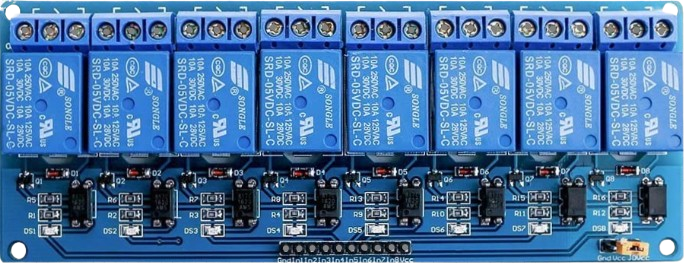
 Design with 8 Channel 5v Relay in Cirkit Designer
Design with 8 Channel 5v Relay in Cirkit DesignerIntroduction
The 8 Channel 5V Relay (Manufacturer: AC, Part ID: Relay) is a versatile relay module designed to control multiple high-power devices using low-power control signals, typically from a microcontroller such as an Arduino. This module features 8 independent relays, allowing users to switch up to 8 devices simultaneously. It operates on a 5V power supply and is ideal for applications requiring electrical isolation and high-current switching.
Explore Projects Built with 8 Channel 5v Relay
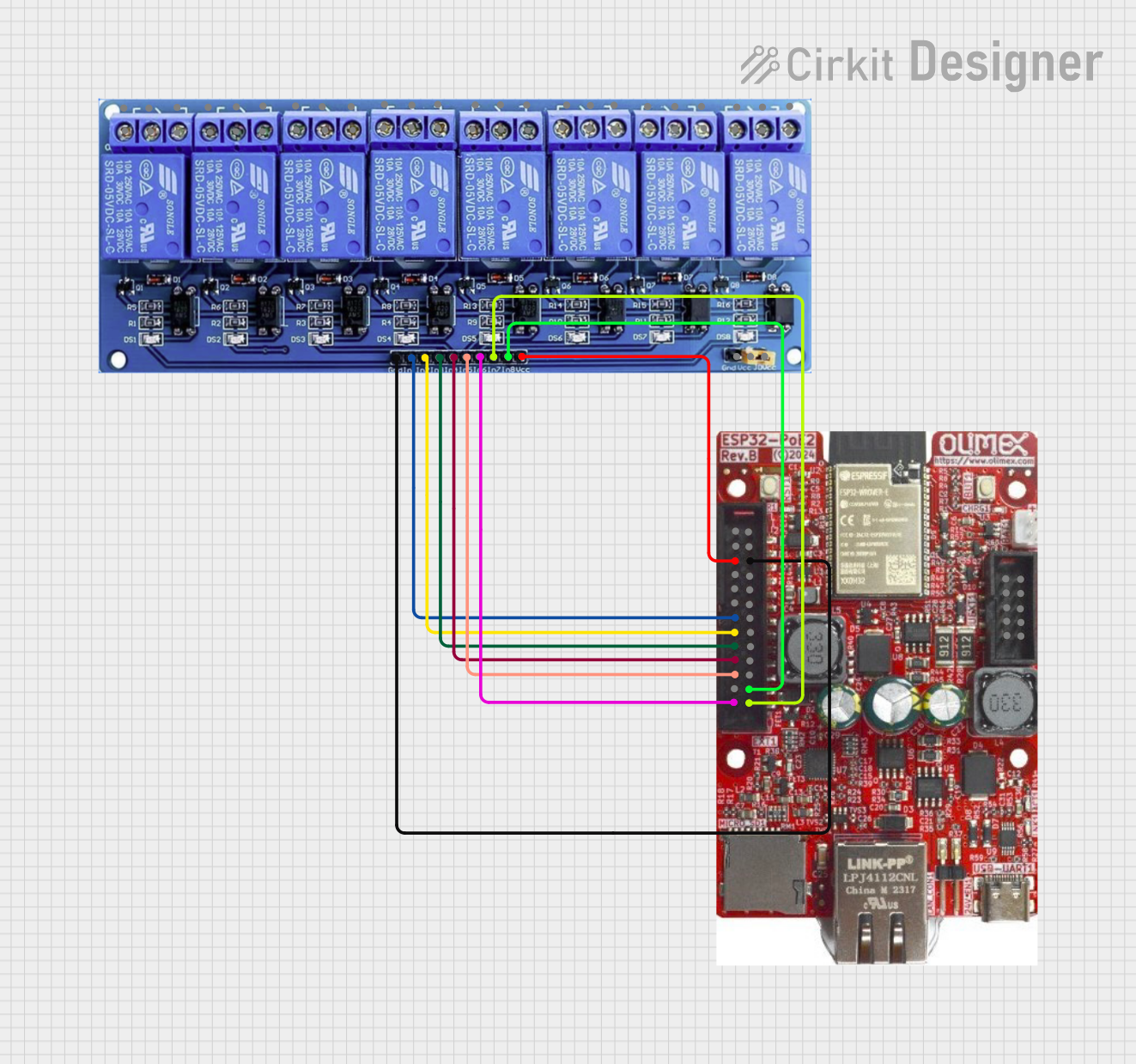
 Open Project in Cirkit Designer
Open Project in Cirkit Designer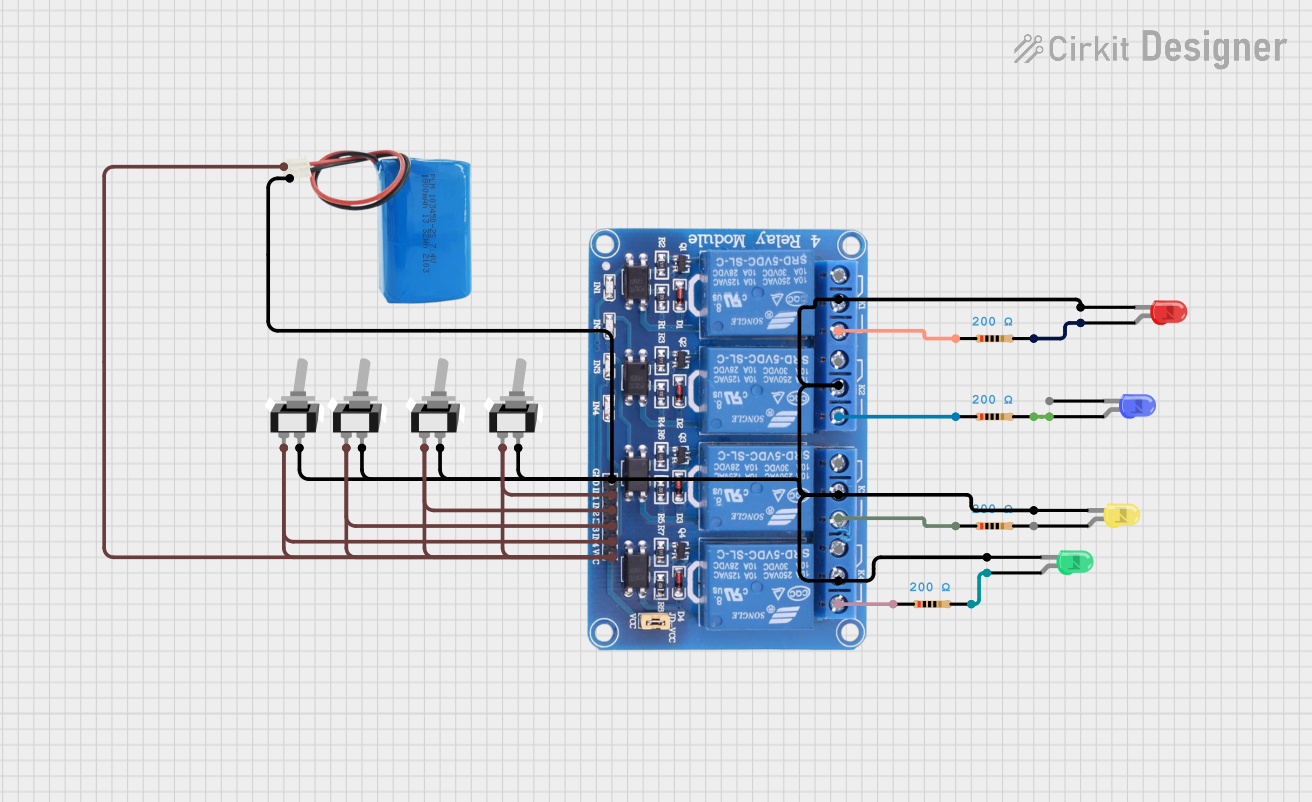
 Open Project in Cirkit Designer
Open Project in Cirkit Designer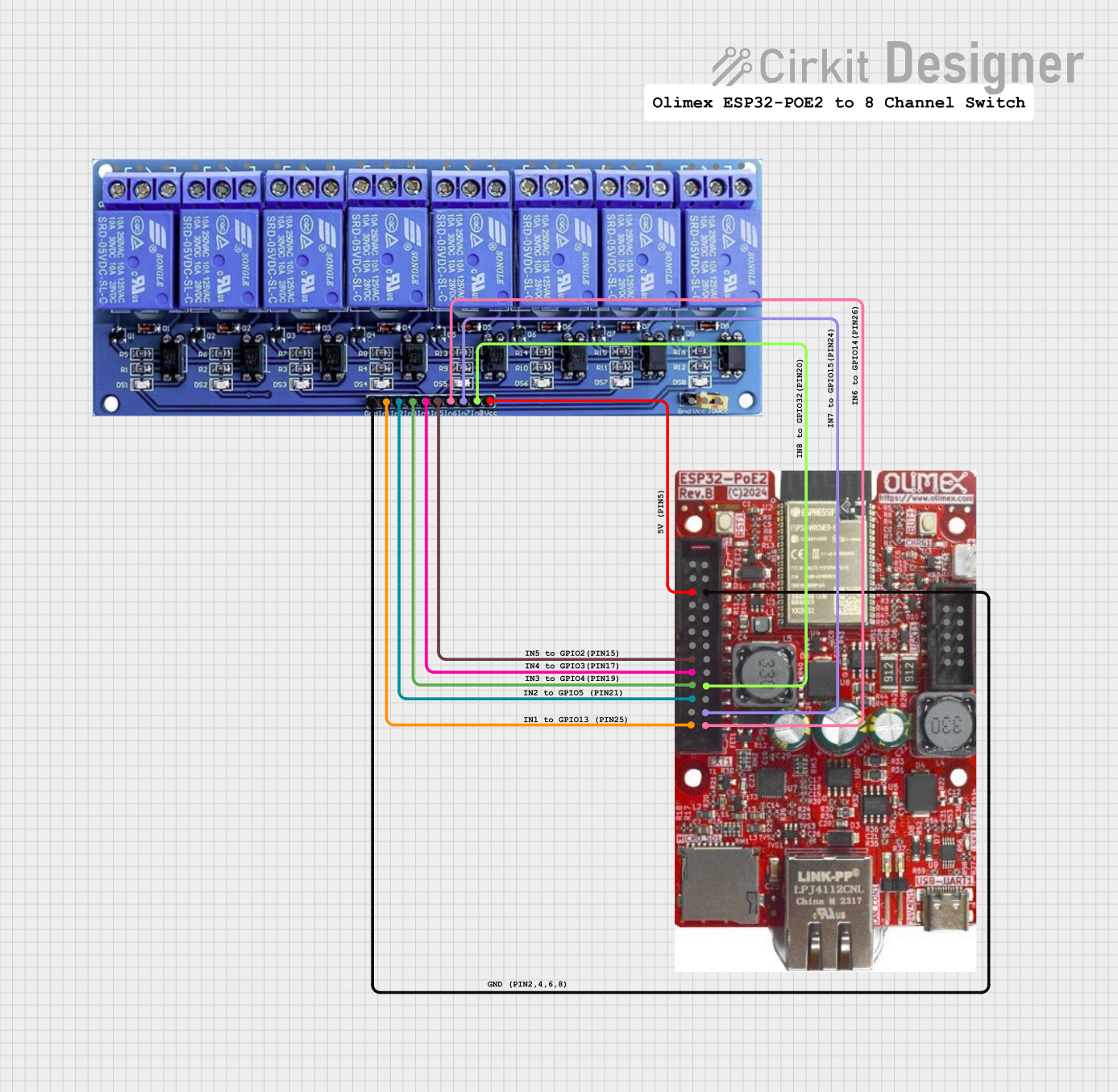
 Open Project in Cirkit Designer
Open Project in Cirkit Designer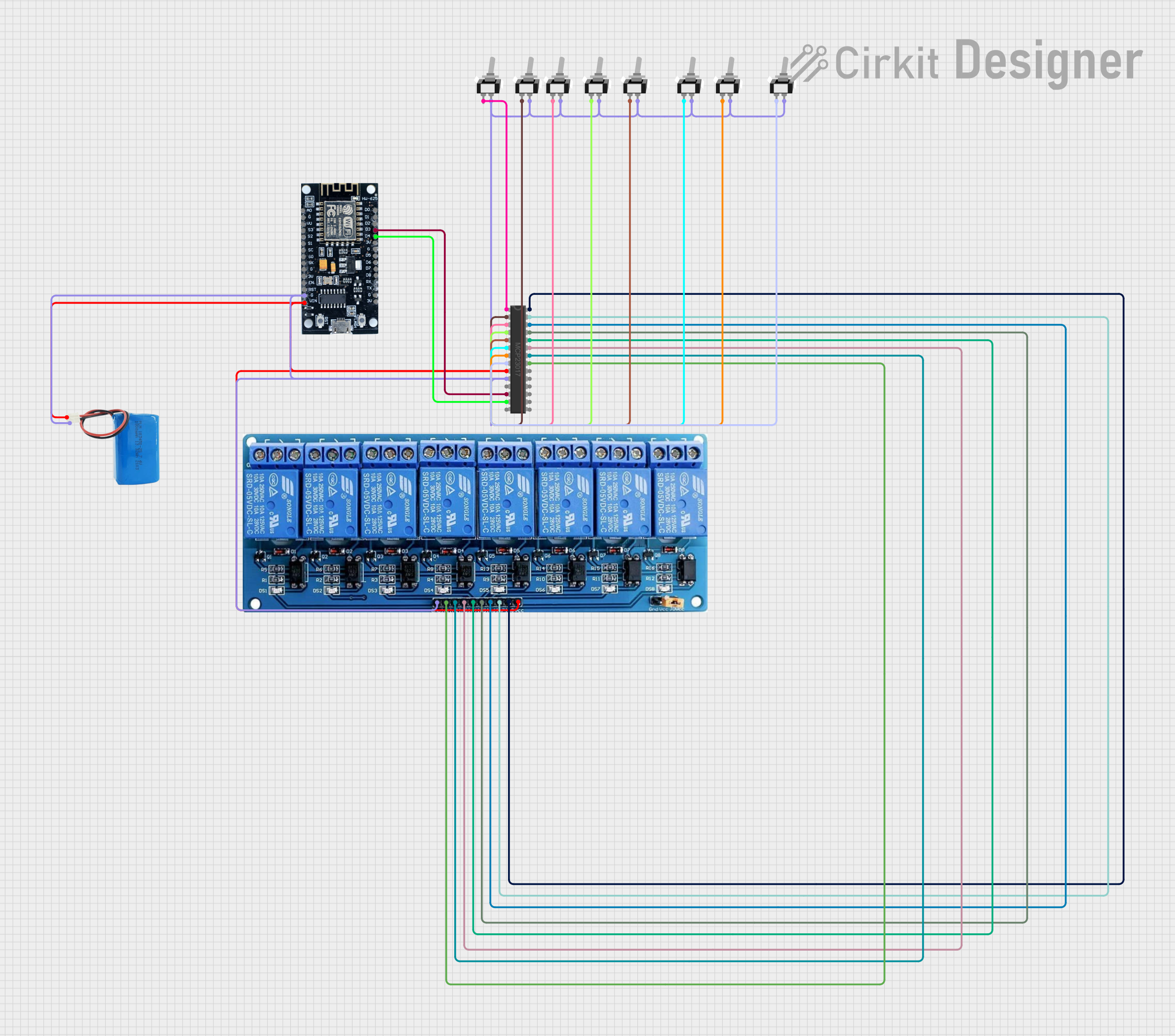
 Open Project in Cirkit Designer
Open Project in Cirkit DesignerExplore Projects Built with 8 Channel 5v Relay

 Open Project in Cirkit Designer
Open Project in Cirkit Designer
 Open Project in Cirkit Designer
Open Project in Cirkit Designer
 Open Project in Cirkit Designer
Open Project in Cirkit Designer
 Open Project in Cirkit Designer
Open Project in Cirkit DesignerCommon Applications
- Home automation (e.g., controlling lights, fans, or appliances)
- Industrial automation and control systems
- Robotics and motor control
- IoT (Internet of Things) projects
- Security systems (e.g., activating alarms or locks)
Technical Specifications
Below are the key technical details of the 8 Channel 5V Relay module:
| Parameter | Specification |
|---|---|
| Operating Voltage | 5V DC |
| Trigger Voltage | 3.3V to 5V DC |
| Relay Type | Electromechanical |
| Number of Channels | 8 |
| Maximum Load (AC) | 250V AC at 10A |
| Maximum Load (DC) | 30V DC at 10A |
| Isolation | Optocoupler isolation for each relay |
| Dimensions | ~140mm x 50mm x 20mm |
| Weight | ~120g |
Pin Configuration and Descriptions
The module has two main sections: the control pins and the relay output terminals.
Control Pins
| Pin Name | Description |
|---|---|
| VCC | Connect to 5V power supply. |
| GND | Connect to ground. |
| IN1 to IN8 | Control pins for each relay channel. A LOW signal activates the corresponding relay. |
Relay Output Terminals
Each relay has three output terminals:
| Terminal | Description |
|---|---|
| NO (Normally Open) | Open circuit when the relay is inactive. Closes when the relay is activated. |
| NC (Normally Closed) | Closed circuit when the relay is inactive. Opens when the relay is activated. |
| COM (Common) | Common terminal for the relay. Connect the load to this terminal. |
Usage Instructions
How to Use the 8 Channel 5V Relay in a Circuit
- Power the Module: Connect the VCC pin to a 5V power supply and the GND pin to ground.
- Connect the Control Signals: Use a microcontroller (e.g., Arduino) to send control signals to the IN1 to IN8 pins. A LOW signal activates the corresponding relay.
- Connect the Load: For each relay, connect the load to the NO or NC terminal and the COM terminal, depending on whether you want the load to be normally off or on.
- Test the Circuit: Ensure all connections are secure and test the circuit by toggling the control signals.
Important Considerations and Best Practices
- Power Supply: Ensure the module is powered with a stable 5V DC supply. Avoid exceeding the voltage rating.
- Isolation: The module features optocoupler isolation, which protects the control circuit from high voltages. However, ensure proper grounding to avoid electrical noise.
- Load Ratings: Do not exceed the maximum load ratings (250V AC at 10A or 30V DC at 10A) to prevent damage to the relays.
- Inductive Loads: When switching inductive loads (e.g., motors), use a flyback diode across the load to suppress voltage spikes.
Example: Connecting to an Arduino UNO
Below is an example of how to control the 8 Channel 5V Relay module using an Arduino UNO:
Circuit Connections
- Connect the relay module's VCC to the Arduino's 5V pin.
- Connect the relay module's GND to the Arduino's GND pin.
- Connect the IN1 to IN8 pins to digital pins 2 to 9 on the Arduino.
Arduino Code
// Example code to control an 8 Channel 5V Relay module with Arduino UNO
// Define the relay control pins
const int relayPins[] = {2, 3, 4, 5, 6, 7, 8, 9};
void setup() {
// Initialize all relay pins as OUTPUT
for (int i = 0; i < 8; i++) {
pinMode(relayPins[i], OUTPUT);
digitalWrite(relayPins[i], HIGH); // Set all relays to OFF state
}
}
void loop() {
// Example: Sequentially turn on each relay for 1 second
for (int i = 0; i < 8; i++) {
digitalWrite(relayPins[i], LOW); // Activate relay (LOW signal)
delay(1000); // Wait for 1 second
digitalWrite(relayPins[i], HIGH); // Deactivate relay (HIGH signal)
}
}
Troubleshooting and FAQs
Common Issues and Solutions
Relays Not Activating
- Cause: Insufficient power supply.
- Solution: Ensure the module is powered with a stable 5V DC supply.
Microcontroller Cannot Trigger Relays
- Cause: Control signal voltage is too low.
- Solution: Verify that the control signal voltage is between 3.3V and 5V.
Load Not Switching Properly
- Cause: Incorrect wiring of the load to the relay terminals.
- Solution: Double-check the connections to the NO, NC, and COM terminals.
Relay Module Overheating
- Cause: Exceeding the maximum load ratings.
- Solution: Ensure the load does not exceed 250V AC at 10A or 30V DC at 10A.
FAQs
Q: Can I use this module with a 3.3V microcontroller like the ESP8266?
A: Yes, the module can be triggered with 3.3V control signals. However, ensure the VCC pin is still powered with 5V.
Q: Is it safe to use this module for high-power appliances?
A: Yes, as long as the load does not exceed the maximum ratings. For added safety, use proper fuses and circuit breakers.
Q: Can I control DC motors with this relay module?
A: Yes, but for inductive loads like motors, use a flyback diode to protect the relay from voltage spikes.
Q: What happens if I connect the relays incorrectly?
A: Incorrect wiring may result in the load not switching or potential damage to the module. Always double-check connections before powering the circuit.